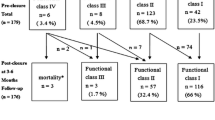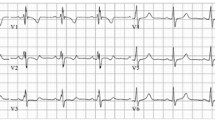Abstract
Conduction abnormalities and arrhythmias may occur in patients following secundum atrial septal defect (ASD) closure using the Amplatzer® septal occluder (ASO). Therefore, the aim of this study was to prospectively perform ambulatory ECG monitoring to assess the electrocardiographic effects of transcatheter closure (TCC) of ASD using the ASO device.
From 5/97 to 3/99, 41 patients with secundum ASD, underwent TCC using the ASO device at a median age of 9.2[emsp4 ]y. (0.5–87[emsp4 ]y.) and median weight of 34[emsp4 ]kg (5.6–88[emsp4 ]kg.). Ambulatory Holter monitoring was performed pre- and immediately post TCC. Holter analysis included heart rate (HR), ECG intervals, supraventricular ectopy (SVE), ventricular ectopy (VE), and AV block.
No change in baseline rhythm was noted in 37 patients (90%). Changes in AV conduction occurred in 3 patients (7%), including intermittent second degree AV block type II, and complete AV dissociation post closure. SVE was noted in 26 patients (63%) post closure, ranging from 5–2207 supraventricular premature beats (SVPB), including 9 patients (23%) with non-sustained supraventricular tachycardia (SVT), 3 of whom had short runs of SVT prior to closure. A significant increase in post-closure number of SVPB per hour (p=0.047) was noted. No significant difference was noted in PR interval, ventricular premature beats per hour, or QRS duration.
Conclusions: Based on ambulatory ECG analysis, TCC of ASD with the ASO device is associated with an acute increase in SVE and a small risk of AV conduction abnormalities, including complete heart block. Long term follow-up studies will be necessary to determine late arrhythmia prevalence and relative frequency compared with standard surgical ASD repair.
Similar content being viewed by others
References
Shiku DJ, Stijns M, Lintermans JP, Vliers A. Influence of age on atrioventricular conduction intervals in children with and without atrial septal defect. J Electrocardiol 1982;15:9-14.
Garson A Jr. Interventricular conduction disturbance. In: The electrocardiogram in infants and children: a systematic approach. Philadelphia: Lea & Febiger, 1983:125-126.
Murphy JG, Gersh BJ, McGoon MD, Mair DD, Porter CJ, Ilstrup DM, McGoon DC, Puga FJ, Kirklin JW, Danielson GK. Long-term outcome after surgical repair of isolated atrial septal defect. N Engl J Med 1990;323:1644-50.
Horvath KA, Burke RP, Collins JJ, Cohn LH. Surgical treatment of adult atrial septal defect: early and long-term results. J Am Coll Cardiol 1992;20:1156-1159.
Konstantinides S, Geibel A, Olschewski M. A comparison of surgical and medical therapy for atrial septal defects in adults. N Engl J Med 1995;333:469-473.
Gatzoulis MA, Freeman MA, Siu SC, Webb GD, Harris L. Atrial arrhythmia after surgical closure of atrial septal defects in adults. N Engl J Med 1999;340:839-846.
Campbell M. Natural history of atrial septal defect. Br Heart J 1970;32:820-826.
Bink-Boelkens MT, Meuzelaar KJ, Eygelaar A. Arrhythmias after repair of secundum atrial septal defect: The influence of surgical modification. Am Heart J 1988;115:629-633.
Karpawich PP, Antillon JR, Cappola PR, Agarwal KC. Pre-and postoperative electrophysiologic assessment of children with secundum atrial septal defect. Am J Cardiol 1985;55:519-521.
Bagger JP, Thomson PEB, Bjerregaard P, Gotzsche H, Rasmussen K. Intracardiac electrography in patients before and after surgical repair of secundum atrial septal defect. J Electrocardiology 1984;17(4):347-352.
Meijboom F, Hess J, Szatmari A, Utens EM, McGhie J, Deckers JW, Roelandt JR, Bos E. Long-term follow-up (9 to 20 y) after surgical closure of atrial septal defect at a young age. Am J Cardiol 1993;72:1431-1434.
Clark EB, Kugler JD. Preoperative secundum atrial septal defect with coexisting sinus node and atrioventricular node dysfunction. Circulation 1982;65:976-980.
Ruschhaupt DG, Khoury L, Thilenius OG, Repogle RL, Arcilla RA. Electrophysiologic abnormalities of children with ostium secundum atrial septal defect. Am J Cardiol 1984;53:1643-1647.
Masura J, Gavora P, Formanek A, Hijazi ZM. Transcatheter closure of secundum atrial septal defects using the new self-centering Amplatzer septal occluder: Initial human experience. Cathet Cardiovasc Diagn 1997;42:388-393.
Bazett HC. An analysis of the time relationships of the heart. Heart 1920;7:353-370.
Rao PS, Sideris EB, Hausdorf G, Rey C, Lloyd TR, Beekman RH, Worms AM, Bourlon F, Onorato E, Khalilullah M. International experience with secundum atrial septal defect occlusion by the buttoned device. Am Heart J 1994;128:1022-1035.
Justo RN, Nykanen DG, McCrindle BW, Boutin C, Benson LN. The clinical impact of catheter closure of secundum atrial septal defects with the double umbrella device: up to 56 months follow-up. Circulation (Suppl) 1995;92(8):308.
Prieto LR, Foreman CK, Cheatham JP, Latson LA. Intermediate-term outcome of transcatheter secundum atrial septal defect closure using the Bard Clamshell septal umbrella. Am J Cardiol 1996;78(11):1310-1312.
Jenkins KJ, Newburger JW, Faherty C, Hollesen A, Wise J, Dwyer M, Woolsey L, Lock JE. Midterm follow-up using the original Bard Clamshell septal occluder: complete experience at one center. Circulation (Suppl) 1995;92(8):308.
Hijazi ZM, Bova S, Rhodes J. Simultaneous transcatheter closure of two secundum atrial septal defects using the Amplatzer septal occluder. J Interven Cardiol 1998;11:181-184.
Hakim F, Madani A, Samara Y, et al. Transcatheter closure of secundum atrial septal defect in a patient with dextrocardia using the Amplatzer septal occluder. Cathet Cardiovasc Diagn 1998;43:291-294.
Kaulitz R, Paul T, Hausdorf G. Extending the limits of transcatheter closure of atrial septal defects with the double umbrella device (CardioSEAL). Heart 1998;80:54-59.
Zamora R, Rao PS, Lloyd TR, Beekman RH, Sideris EB. Intermediate-term results of phase I food and drug administration trials of buttoned device occlusion of secundum atrial septal defects. J Am Coll Cardiol 1998;31:674-676.
Schenck MH, Sterba R, Roreman CK, Latson LA. Improvement in noninvasive electrophysiologic findings in children after transcatheter atrial septal defect closure. Am J Cardiol 1995;76:696-698.
Das GS, Shrivastava S, O'Laughlin MP, Salmon AP, Mendelsohn AM, Hijazi ZM, Snider J for the investigators. Intermediate term follow-up of patients after percutaneous closure of atrial septal defects with the Das Angel Wings device. Circulation (Suppl) 1996;94(8):56.
Author information
Authors and Affiliations
Rights and permissions
About this article
Cite this article
Hill, S.L., Berul, C.I., Patel, H.T. et al. Early ECG Abnormalities Associated with Transcatheter Closure of Atrial Septal Defects Using the Amplatzer® Septal Occluder. J Interv Card Electrophysiol 4, 469–474 (2000). https://doi.org/10.1023/A:1009852312907
Issue Date:
DOI: https://doi.org/10.1023/A:1009852312907




